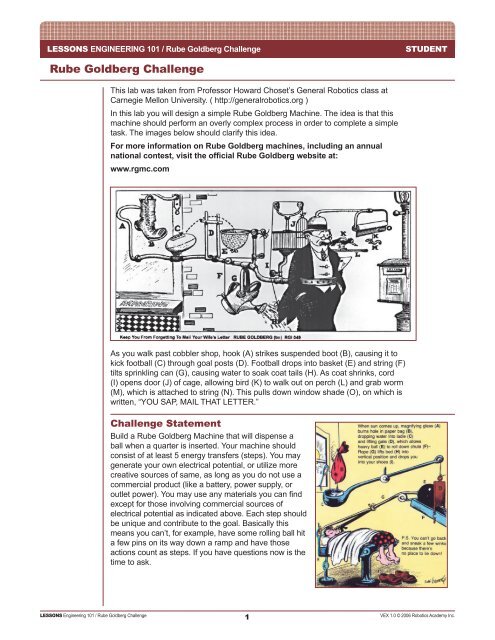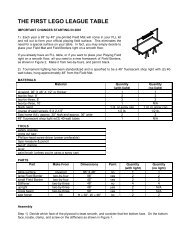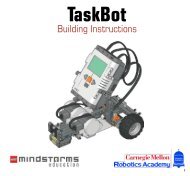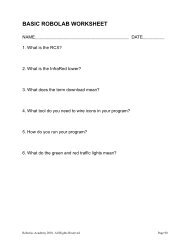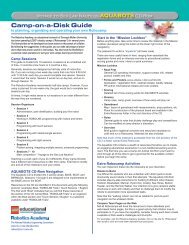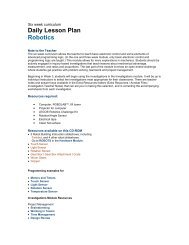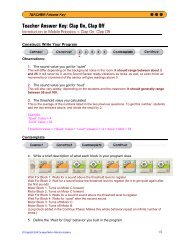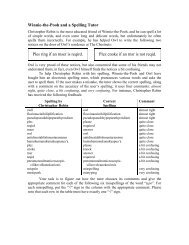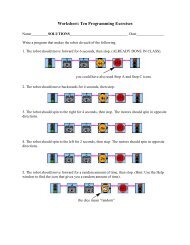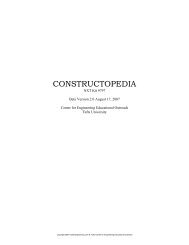Rube Goldberg Challenge - Robotics Academy - Carnegie Mellon ...
Rube Goldberg Challenge - Robotics Academy - Carnegie Mellon ...
Rube Goldberg Challenge - Robotics Academy - Carnegie Mellon ...
You also want an ePaper? Increase the reach of your titles
YUMPU automatically turns print PDFs into web optimized ePapers that Google loves.
LESSONS LESSONSENGINEERING Engineering 101 101 / <strong>Rube</strong> <strong>Goldberg</strong> <strong>Challenge</strong> STUDENT<br />
STUDENT<br />
<strong>Rube</strong> <strong>Goldberg</strong> <strong>Challenge</strong><br />
This lab was taken from Professor Howard Choset’s General <strong>Robotics</strong> class at<br />
<strong>Carnegie</strong> <strong>Mellon</strong> University. ( http://generalrobotics.org )<br />
In this lab you will design a simple <strong>Rube</strong> <strong>Goldberg</strong> Machine. The idea is that this<br />
machine should perform an overly complex process in order to complete a simple<br />
task. The images below should clarify this idea.<br />
For more information on <strong>Rube</strong> <strong>Goldberg</strong> machines, including an annual<br />
national contest, visit the offi cial <strong>Rube</strong> <strong>Goldberg</strong> website at:<br />
www.rgmc.com<br />
As you walk past cobbler shop, hook (A) strikes suspended boot (B), causing it to<br />
kick football (C) through goal posts (D). Football drops into basket (E) and string (F)<br />
tilts sprinkling can (G), causing water to soak coat tails (H). As coat shrinks, cord<br />
(I) opens door (J) of cage, allowing bird (K) to walk out on perch (L) and grab worm<br />
(M), which is attached to string (N). This pulls down window shade (O), on which is<br />
written, “YOU SAP, MAIL THAT LETTER.”<br />
<strong>Challenge</strong> Statement<br />
Build a <strong>Rube</strong> <strong>Goldberg</strong> Machine that will dispense a<br />
ball when a quarter is inserted. Your machine should<br />
consist of at least 5 energy transfers (steps). You may<br />
generate your own electrical potential, or utilize more<br />
creative sources of same, as long as you do not use a<br />
commercial product (like a battery, power supply, or<br />
outlet power). You may use any materials you can fi nd<br />
except for those involving commercial sources of<br />
electrical potential as indicated above. Each step should<br />
be unique and contribute to the goal. Basically this<br />
means you can’t, for example, have some rolling ball hit<br />
a few pins on its way down a ramp and have those<br />
actions count as steps. If you have questions now is the<br />
time to ask.<br />
LESSONS Engineering 101 / <strong>Rube</strong> <strong>Goldberg</strong> <strong>Challenge</strong> 1<br />
VEX 1.0 © 2006 <strong>Robotics</strong> <strong>Academy</strong> Inc.
LESSONS LESSONSENGINEERING Engineering 101 101 / <strong>Rube</strong> <strong>Goldberg</strong> <strong>Challenge</strong> STUDENT<br />
STUDENT<br />
<strong>Rube</strong> <strong>Goldberg</strong> <strong>Challenge</strong><br />
Up to two human interventions are permitted: one to start the machine, and one to<br />
intervene if something unexpected occurs.<br />
Bonus points – 5 bonus points will be awarded when two teams can get their<br />
<strong>Goldberg</strong> machines to work together.<br />
Size constraints:<br />
1. Base: 3’ x 4’ maximum<br />
2. Height: 5’ maximum<br />
Hand in<br />
1. Your group’s <strong>Rube</strong>-<strong>Goldberg</strong> Machine<br />
2. A hard copy of an html-based presentation that<br />
a. Depicts your Group’s name and members’ names.<br />
b. Contains pictures of your <strong>Rube</strong>-<strong>Goldberg</strong> Machine<br />
c. Lists the energy transfers<br />
3. A copy of the grading sheet, below.<br />
Evaluation<br />
1. A (95): 5 energy transfers (steps)<br />
2. B (85): 4 energy transfers (steps)<br />
3. C (75): 3 energy transfers (steps)<br />
4. D (65): 2 energy transfers (steps)<br />
5. F (55): < 2 energy transfers or it doesn’t work<br />
6. F- (0): No machine at all<br />
Five bonus points will be awarded if your machine can be attached to another<br />
group’s machine and the two machines can run in SERIAL to create a larger (10+<br />
transfers) <strong>Rube</strong> <strong>Goldberg</strong> machine. If three or more machines can be attached<br />
serially (15+ transfers), two additional points will be given for each successfully<br />
attached machine. For example, if four machines connected in serial successfully<br />
complete the goal, each team will receive 5 + 2 + 2 = 9 bonus points for a total grade<br />
of 104 per team!<br />
A serially connected <strong>Rube</strong> <strong>Goldberg</strong> Machine is defi ned as one whose fi rst energy<br />
transfer is initiated by the fi nal energy transfer of the previous machine.<br />
A parallel connected <strong>Rube</strong> <strong>Goldberg</strong> Machine is defi ned as one whose fi nal energy<br />
transfer triggers multiple energy transfers.<br />
Update for connected machines:<br />
Each machine must operate independently with a quarter, spitting out a ball. When<br />
the machines are connected, the ball from the fi rst machine may trigger that which<br />
the quarter would have triggered on the second machine. You may also choose<br />
to have the ball from the fi rst machine push a quarter into the second machine.<br />
Either solution is fi ne, as long as each machine operates independently (when not<br />
connected) with a quarter.<br />
LESSONS Engineering 101 / <strong>Rube</strong> <strong>Goldberg</strong> <strong>Challenge</strong> 2<br />
VEX 1.0 © 2006 <strong>Robotics</strong> <strong>Academy</strong> Inc.


